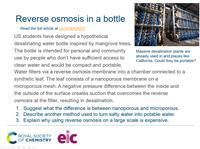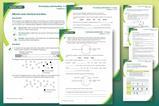Students are looking to mangroves for inpiration to turn salty seawater to safe drinkable water
Four students in the US have designed a desalinating water bottle. The currently hypothetical device would be compact and portable.
Their design is inspired by mangrove trees, which use thermal and membrane-based desalination techniques to grow in saltwater in the tropics. It includes an input chamber, which users fill with saltwater, connected to a reverse osmosis membrane. Water filters via the membrane into an intermediate chamber connected to a synthetic leaf. The leaf consists of a nanoporous membrane on a microporous mesh. On evaporation, the water menisci within the pores become concave resulting in a negative pressure difference between the inside and the outside of the surface. This creates suction that can overcome reverse osmosis at the filter, resulting in desalination.
Put this in context
Add context and highlight diverse careers with our short career videos showing how chemistry is making a difference and let your learners be inspired by chemists like Joseph, a laboratory analyst and higher degree apprentice working to carry out vital safety tests on drinking water.
The group says the design has several advantages over existing work on synthetic trees. They added a solar fin around the bottle to accelerate the rate at which the water would flow through the filter. This would increase the transpiration rate, ensuring the process is faster than previously reported devices. The bottle is intended for personal and community use by people who don’t have sufficient access to clean water; the proposed single column structure ensures the device is portable.
As the design is only preliminary, the next step for the team would be to create a prototype. Constructing a physical device would involve addressing the challenge of material costs to ensure the device is accessible for the intended users.
Read the full story in Chemistry World.
A one-slide summary of this article with questions to use with your 14–16 students: rsc.li/3MpVAi2
Downloads
EiC starter slide Reverse osmosis desalination
Presentation | PowerPoint, Size 0.13 mbEiC starter slide Reverse osmosis desalination
Presentation | PDF, Size 0.16 mb















No comments yet